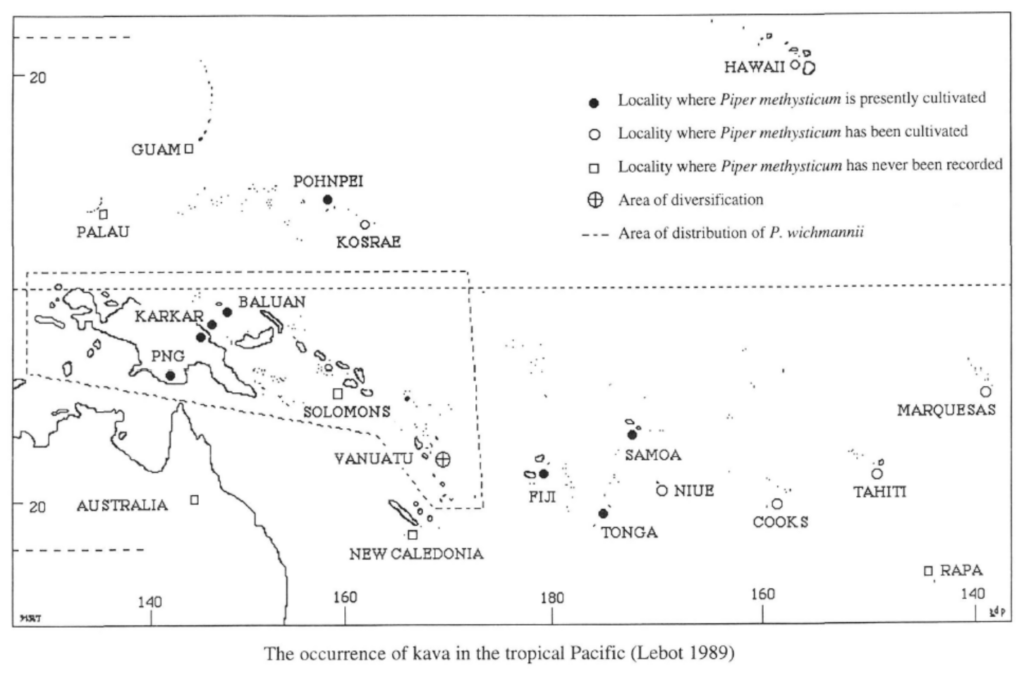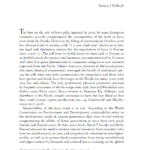Summary of: The Origin And Distribution Of Kava. Dr. Vincent Lebot. 1995.

Citation: Lebot, Vincent. 1995. “The Origin And Distribution Of Kava.” Canberra Anthropology 18 (1-2): 20–33. https://doi.org/10.1080/03149099509508407.
Fast Summary:
- The paper titled “The Origin And Distribution Of Kava” by Vincent Lebot, published in Canberra Anthropology, explores the origin, distribution, botany, genetic variation, and potential cultivation of kava (Piper methysticum), a psychoactive plant used to make a traditional drink in Oceania.
Full Summary:
- Introduction (Page 2):
- Kava, formally known as Piper methysticum, is a perennial shrub that has been traditionally used to prepare a psychoactive beverage in the Pacific Islands. This plant holds a unique distinction—it is the only economically significant plant species that is confined exclusively to the Pacific region. The roots of the kava plant are particularly noteworthy, as they contain up to 20% kavalactones. These active compounds have not only cultural significance but also have piqued the interest of the European pharmaceutical industry for their potential medicinal properties.
- Botanical Characteristics (Page 2):
- From a botanical perspective, kava is a member of the Piperaceae family. It is a slow-growing perennial shrub that can attain heights of over three meters. The plant is characterized by its thin, heart-shaped leaves and a starchy root system that is both extensive and voluminous. Although the plant does produce flowers, it is incapable of sexual reproduction. This means that the propagation of kava is entirely dependent on human intervention, usually through cuttings or other forms of asexual reproduction.
- Ancestral Candidate and Geographic Distribution (Pages 2-3):
- The paper identifies Piper wichmannii as the most probable ancestral candidate for Piper methysticum. The origins of kava are believed to be rooted in Melanesia, with specific regions of interest including New Guinea, the Solomon Islands, and Vanuatu. The paper goes beyond mere identification and also provides geographical maps that outline the general areas where kava has been historically cultivated. This is particularly useful for understanding the unique and disjunct distribution patterns of this plant species.
- Genetic Variation, Polymorphism, and Chemotypes (Pages 5-6):
- A comprehensive survey was undertaken to evaluate the influence of environmental factors on the biosynthesis of kavalactones and to scrutinize the level of polymorphism within the species. The study revealed significant differences among various kava cultivars, both in terms of their morphological characteristics and chemical composition. High Performance Liquid Chromatography (HPLC) was employed to analyze more than 300 root samples, revealing nine distinct chemotypes, each with unique physiological properties and applications (Page 5). Intriguingly, these chemotypes are genetically determined and are not influenced by external environmental factors or the age of the plant. The study also noted that there was no clear correlation between the morphological types (morphotypes) and chemical types (chemotypes), suggesting a complex interplay between these two aspects.
- Isozyme Analysis and Genetic Markers (Pages 7-8):
- Isozyme analysis was utilized as a sophisticated technique to further characterize and differentiate between various kava cultivars. The study found an exceptionally low level of isozymic variability in Piper methysticum, leading to the conclusion that the plant essentially comprises a group of sterile clones. These clones are believed to be the result of selective human intervention, particularly the selection of somatic mutants. The closest zymotype of Piper wichmannii was identified in Vanuatu, thereby strengthening the hypothesis that Piper methysticum could very well have originated from this region (Page 7).
- Conclusion (Pages 9-10):
- Cytological data collated in the study indicated that the chromosome count is consistent across three Piper taxa, each having 130 chromosomes. The paper concludes by stating that Piper methysticum is not a separate botanical species. Instead, it is a collection of sterile cultivars that have been selectively bred from somatic mutants of Piper wichmannii. The geographical origin of Piper methysticum aligns well with the distribution range of Piper wichmannii, covering key regions such as New Guinea, the Solomon Islands, and northern Vanuatu.
Notes:
- Vincent Lebot’s paper serves as a comprehensive resource that delves into multiple facets of kava, from its botany and ancestral lineage to its genetic variation and chemotypes. The paper not only enriches our understanding of this unique plant but also sets the stage for future research. This could include exploring the genetic mechanisms behind the various chemotypes and their potential applications in pharmaceuticals, thereby opening new avenues in both cultural and scientific domains.



